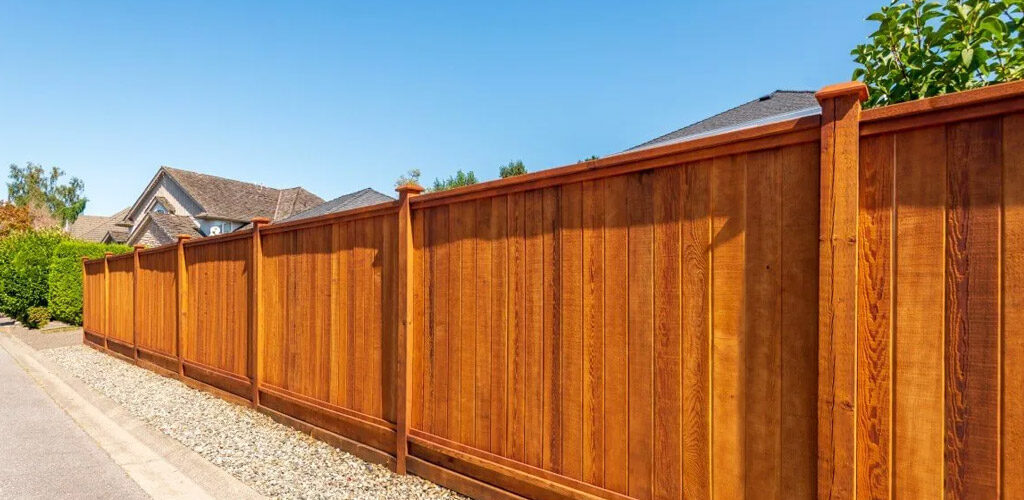When to Stain a New Fence (Cedar, Pine, & Pressure Treated Wood)
Key Takeaways
-
When to stain: Why most new fences need about 4–8 weeks to dry before staining – and why pressure-treated wood can take even longer.
-
How to test readiness: A simple water-bead test to tell if your fence is dry enough to absorb stain.
-
Seasonal tips: How Southern Oregon’s wet winters and hot summers affect drying times and the best staining window.
-
Prep for lasting results: Key steps – cleaning, checking moisture, and picking the right stain – to help your fence stay beautiful and protected for years.
A brand-new fence instantly boosts curb appeal and privacy, but the job isn’t finished until it’s properly stained. Staining protects the wood from moisture, sun damage, and everyday wear. The tricky part? Timing. Stain too soon and you can trap moisture; wait too long and the wood can dry out, crack, or turn gray. Here’s how to get it right for Southern Oregon’s wet winters and hot, dry summers.
Why Timing Matters
Fresh wood contains natural oils and internal moisture. If you apply stain before that moisture escapes, the finish can blister, peel, or fail to penetrate. On the other hand, leaving the wood unprotected for months exposes it to ultraviolet rays and rain, which break down fibers and cause fading. The goal is to let the fence dry just enough for the stain to soak in deeply while the wood is still fresh.
The General Rule of Thumb
For most new fences, plan to stain after 4–8 weeks of weathering. This gives the wood time to shed surface moisture and mill glaze while staying protected from prolonged sun damage. However, that range can shift based on a few important factors.
Factors That Affect Drying Time
Wood Type
- Cedar and Redwood: Naturally lower moisture content, often ready closer to the four-week mark.
- Pine and Spruce: Typically need the full 6–8 weeks.
- Pressure-Treated Lumber: Because it’s infused with water-borne preservatives, it may need several months to dry.
Southern Oregon Climate
- Wet Winters: Persistent rain slows drying, so fall or winter installations may need extra time.
- Hot Summers: Warm, dry weather speeds the process, but direct sun can cause uneven drying if one side bakes while the other stays shaded.
Sun & Shade
Sections shaded by trees or neighboring structures often retain moisture longer than those in full sun.
The Water-Bead Test
If you’re still not sure how to tell if a fence is dry enough to stain, try the water-bead test. Sprinkle a little water on the boards. If it beads up, the wood is still too wet. If it soaks in within a few seconds, you’re ready to stain.
Pre-Stain Preparation
Even new fences collect construction dust, pollen, and mill glaze that can block stain absorption.
- Clean: Gently wash or light pressure-wash to remove debris.
- Dry: Allow at least 24–48 hours of dry weather after washing.
- Check the Forecast: You’ll need a rain-free window for application and curing.
Choosing the Right Stain
- Semi-Transparent vs. Solid: Semi-transparent shows off the wood grain; solid offers more UV protection and color options.
- Oil-Based vs. Water-Based: Oil-based stains penetrate deeply and handle Southern Oregon’s sun well, while high-quality water-based products are easier to clean and environmentally friendly.
- UV Inhibitors: A must for fences that bake in the summer sun.
Professional Fence Staining vs. DIY
While staining can be a homeowner project to save on the cost of fence staining, there’s more to it than a brush and a free weekend. Professionals:
- Use moisture meters to confirm the wood is ready.
- Apply stain evenly with sprayers and/or brushes for a smooth finish.
- Understand how to work around landscaping and handle tricky spots like gates and corners.
A professional job ensures the stain bonds properly and lasts longer, saving you money on early re-coats.
How Pacific Home Painting Can Help
At Pacific Home Painting, we combine deep knowledge of Southern Oregon’s weather with expert prep and application. Our services include:
- Fence washing and drying for optimal stain absorption.
- Moisture testing to determine the perfect staining window.
- Eco-friendly products and careful protection of your landscaping.
Whether your fence is made of cedar, pine, or pressure-treated lumber, we’ll select the right stain and apply it for long-lasting beauty.
Tips to Extend the Life of Your Fence
- Recoat Every 2–3 Years: Inspect annually and refresh as needed.
- Trim Plants: Keep vegetation from trapping moisture against the boards.
- Adjust Sprinklers: Prevent constant water spray on the fence.
- Light Annual Cleaning: A gentle wash helps prevent dirt and mildew from accumulating.
Ready to Protect Your New Fence?
Timing is everything. Stain too soon and you risk peeling; wait too long and the wood weathers. By monitoring the calendar, checking for moisture, and preparing the surface, you can maintain your fence’s appearance for years.
Need help finding the perfect window to stain your fence? Contact Pacific Home Painting for a free estimate. We proudly serve Grants Pass, Medford, Ashland, and the surrounding Southern Oregon communities.
FAQ’s
The general recommendation is 4–8 weeks, though cedar or redwood may need closer to four weeks, and pressure-treated lumber may require several months to dry properly.
Use the water-bead test: sprinkle water on the boards. If it beads up, the wood is still too wet. If it soaks in within a few seconds, the wood is likely ready.
Yes. Wet winters delay drying, hot summers can speed it up – but direct sun, smoke, or extreme heat can cause uneven drying or reduced stain absorption.
Usually, every 2 – 3 years, though the schedule depends on the exposure to sun, moisture, and whether maintenance (like cleaning and sealing) has been kept up.
.
